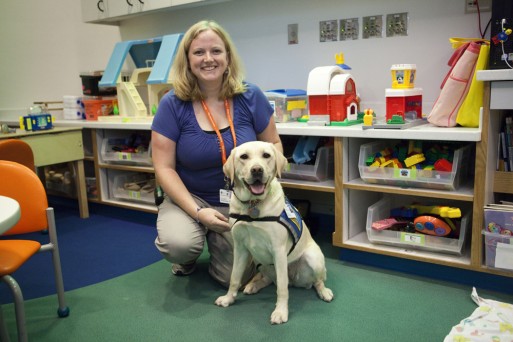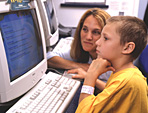
Child Life Specialist Jennifer Belke and Canine Companion Niliani
The UCSF Benioff Children’s Hospital, part of the University of California Medical Center in San Francisco, is one of the top children’s hospitals in the nation. They offer compassionate care for virtually all pediatric conditions, including cancer, heart disease, neurological disorders, organ transplants and orthodpedics. Within the hospital, the Child Life Department works with children, teens, and their families to ensure a child’s emotional and developmental needs are met throughout their admission to the hospital.
Jennifer Belke is the Child Life Playroom Coordinator, as well as caretaker to a very special addition to the hospital, Nilani, a facility service dog who helps care for and play with the children and their families. She talked with me about the Playroom services and the work Nilani — or “Lani”, as the kids call her — does around the hospital.
Dana: What is the purpose of the Child Life Department within the Children’s Hospital?
Jennifer: The basis of Child Life is play. That is how we assess a child, how we see how they’re coping, how we can tell what they know about what’s going on. Child Life is about helping a kid feel safe and comfortable in the hospital. We try to normalize the environment, which is where the Playroom comes in. We offer them things they’d be doing at home or at school.
A basic day when a child comes into the hospital would be: First we work with parents to find out what language they’ve been using. We talk with the doctors to find out what the kid will have to deal with thile they’re here — what procedures, what medicines they’ll be taking. Then we talk with the parents to let them know what we know and work together with the child to help them understand the procedures at their developmentally appropriate language. For example, some children hear things very literally, so for young kids a lot of times when we say “I.V.” they hear “ivy”, and they think of the plant. We have to explain that to them in language they understand, so “I.V.” could be called “medicine tube.”
We’re what I call “developmental translators” for medical jargon. Once the kids know what their senses will encounter while they’re here, they’re more calm and less afraid of the hospital.
Once we explain a particular procedure, we come up with a coping plan to help them be comfortable during the procedure. We make sure everyone knows the plan — the doctors, nurses, parents, anyone who will be in the room — so we can all work together and help them cope through it. At the end of the procedure, we congratulate them for mastering it, say something like, “You did such a great job staying still,” or whatever they had to work hard to do.
We go through this process for every single procedure during the entire admission. In between procedures they can come to our other programming, which includes the Playroom, as well as educational activities. We help a lot with school re-entry. When kids go back to school it can be hard for them to explain to classmates where they’ve been, why they have a tube in their nose, etc. We help them know how to explain that, and we help them keep up on homework while they’re here, so they aren’t behind once they get back.
Dana: Who are the children you serve – what medical conditions are they facing?
Jennifer: We serve children with everything from broken bones and infections to oncology and end-of-life. Anything a child would be admitted to the hospital for.
Dana: What unique challenges do you see with families facing serious illness or the death of a child?
Jennifer: Every child, even if it’s only a broken bone, or if it’s a chronic illness, they’re being taken out of their routine. They’re afraid of what’s going to happen. Even if they’ve been here a hundred times, that doesn’t mean they’re used to what’s happening to them. Sometimes parents can’t stay with them, so they have that fear, as well.
They face questions like, “Will I be home for the holidays?” A lot of kids have trouble taking pills.
 Dana: It sounds like it’s a lot of fear of the unknown.
Dana: It sounds like it’s a lot of fear of the unknown.
Jennifer: Yes, it’s a lot of that. Also, a lot of kids worry about the way that their parents are going to take things. They don’t want to worry or scare their parents, so they have a lot of anxiety about that.
Dana: I’ve heard of that issue a lot, a surprising fact about kids. How do you address that challenge in particular?
Jennifer: We help them express their feelings and communicate with their parents. One teen, an end-of-life patient, made a huge collage that explained how she was feeling, and gave it to her mom before she died. She was expressing herself so her mom could have that. We sometimes help with those conversations. We ask permission: “Can I tell your mom how you’re feeling?” Or sometimes we’ll be in the room to help them with that conversation. We do a lot of legacy-building.
Dana: Can you explain legacy-building?
Jennifer: If a patient’s unable to participate in end-of-life activities, or to vocalize how they’re feeling, or are heavily medicated and can’t participate in memory-building, we work with the parents to create like a “memory box”. That can contain pictures, locks of hair, etc. For older kids, we give them tape recorders so they can give their parents a tape saying goodbye. It’s a way to create something for the kids to say goodbye, and give the families something to hold on to. It’s really important for the siblings, especially, to be involved, too. We work a lot with siblings, making sure they understand what’s happening, make sure they understand what end of life really is — that their brother or sister is not coming back.
Dana: Tell me about the Playroom.
Jennifer: The Playroom is open three times a day. In the morning is pre-school and toddlers, five years old and under. Afternoons and evenings are all-ages. We create a safe environment where kids know if they go into those rooms nothing will happen to them – no one will poke or prod them or point out what’s wrong with them [medically]. They get to be a kid.
We have an infant corner, a water play area, which is very soothing. There’s an arts and crafts area, a bench with lights and things to stimulate kids. There’s a play kitchen for pretend play. We have tons of art supplies, toys and board games, and a medical play table. That’s very important. Kids use baby dolls for medical play. Real medical instruments and things they’d see in their procedures are left on the table all day, so kids can go and become the doctor, play and experiment and take care of the “baby”. Medical play is so beneficial for kids in the hospital. We also bring it to their room, for kids who can’t come to the Playroom, or we need to discuss certain procedures with them. While they play, we let them do whatever they want, but we observe them, and we can talk to them after. We encourage them to play with things they’re experiencing; kids usually mirror their conditions onto the baby they’re playing with, so if there’s something that’s particularly scary or something they don’t understand, we can see that and talk to them about it later.
Dana: Does medical play help because they get a better understanding of the procedures, or is it about being the “doctor” and taking control of the situation?
Jennifer: Both. We watch and see what they do that’s not actually part of the procedure, and we’ll follow up later, so that helps them get a better understanding. It also gives them control. They can’t take control anywhere in the hospital, so they get it in the Playroom.
The Playroom is used by both patients and siblings, especially during the holidays. It makes the hospital an okay place to be, more normal, less scary.

Nilani, a Canine Companion for Independence
Nilani is a Canine Companion for Independence. She’s trained as a facility service dog. We got her in August of 2010. She is amazing. I heard about canine companions for independence at a hospital in Sacramento where they have three dogs, and immediately I wanted to get that program running for us.
Nilani, on a typical week, will spend four hours a day in the Playroom five days a week. Any kids who can come out of their room can come and see her and play with her. We also take her to the rooms of kids who can’t come to the Playroom. And we use her for rehab, kids to practice motor skills. It’s more fun to put the focus on the dog — rather than just say, “Walk up and down this room three times”, we can say, “Do you want to take Lani for a walk?”
Since Nilani has been here, the number of kids who come down to the Playroom is higher. A lot of kids miss dogs at home, so it helps to have her here with them. She encourages kids to get out of bed and walk. We also have kids who have poor hygeine, so we use Nilani to show them what needs to be done. We can show them how we take care of Nilani, and why it’s important to do it for themselves, too.
We’ve used her for procedures, too. She offers comfort and calm to kids in the rooms. For end-of-life, she senses the emotion in a room. She can walk in and tell whether she’s supposed to be playful or comforting and calming. She senses who needs the most love and care, without being directed, and she’ll go straight to a patient or their family members and offer comfort where it’s needed.
Like most service dogs, she’s extra sensitive because of her training. [Like other medical workers], when Nilani has a very rough week, dealing with a high-emotion patient, she pulls that inside of her and will be sluggish or mildly ill the next day. After the first end-of-life patient, she wouldn’t come out of her kennel or eat the next day. She needed time to deal with that emotion. After that, the next day, she was okay. We help her deal with the high emotion by balancing her interaction with happy and sad kids, taking her to the dog park to let her be a normal dog, etc.
Dana: How can we generally support children and families who are facing serious illness?
Jennifer: For families facing serious illness, the biggest thing we see is parents keeping things from their kids: not telling them where they’re going [when they go to the hospital] or what’s going to happen. The most important thing parents can do is always be honest with the kids. If it’s difficult to have the conversation, they can always call a local Child Life department and ask for advice about how to cope and how to talk about it. One of the number-one fears I see in children is they were lied to before coming to the hospital, and they don’t know what’s going to happen while they’re here.
For friends and other family members, keep checking in with a family after they leave the hospital. I hear from parents all the time, and that’s a huge challenge they face. They get tons of support while they’re in the hospital, but it stops after they go home, when they really need it most. While they’re here, they’ve got social workers and physicians and Child Life specialists to support them, so they need continued support and help after they get home.
Thanks for taking the time to talk, Jennifer!
Learn more about UCSF Benioff Children’s hospital at ucsfbenioffchildrens.org.
Photos by Eric Desch Photography. Courtesy of UCSF Benioff Children’s Hospital.

 How Can We Support Families of Children with Serious Illness? An Interview with Jennifer Belke
How Can We Support Families of Children with Serious Illness? An Interview with Jennifer Belke


 “Help Me, Helen”
“Help Me, Helen”
 Recovering Cremation Remains After the Los Angeles Fires
Recovering Cremation Remains After the Los Angeles Fires
 “As Tears Go By” by Marianne Faithfull
“As Tears Go By” by Marianne Faithfull














